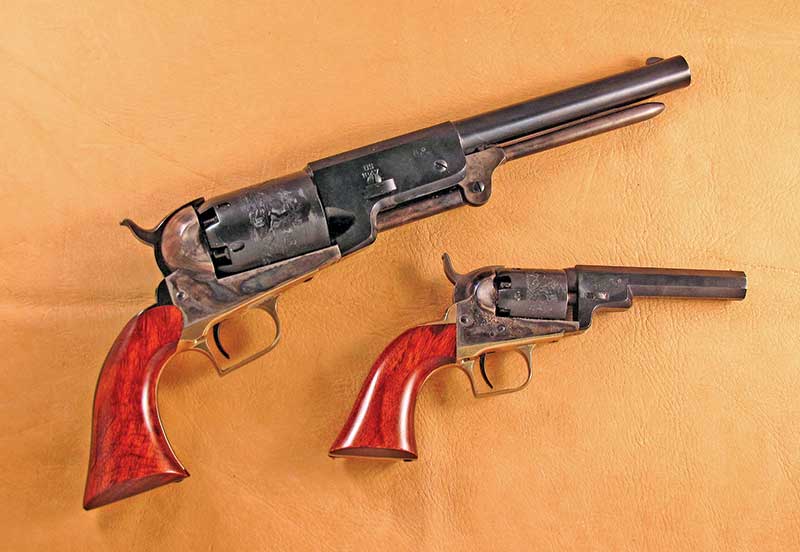Shooting Cap-N-Ball Sixguns
In the 1950’s there were no replica black powders available, so it was strictly real black powder only. When I first started an — original 1860 Army! — I would cast my own round balls of pure lead in a single cavity mould. Today, we not only have replica sixguns we also have several choices in replica black powder, as well as round balls readily available.
The .44 cap-n-balls require experimenting to find the proper diameter ball. Colt 1860 replicas I’ve used need balls of 0.45″ or 0.454″, the Remingtons are at their best with the 0.454″ size and the Walkers are individuals, with some going for the 0.457″ ball while others must have 0.454″ balls. If the round ball is too small it will move forward under recoil, sometimes enough to project out the front of the cylinder and prevent it from rotating.
I’ve found cap-n-ball sixguns to be as accurate as any modern sixgun or semi-auto, but they, of course, can’t be loaded nearly as quickly. The best I could do loading six rounds and then shooting them carefully was about eight minutes. This allowed a lot of thinking time while reloading, which is one of their charms.
The Basics
All cap-n-ball sixguns operate the same way. The powder charge is placed in the cylinder chamber, a wad is placed over the powder if desired, and an over-sized round ball is seated using the built in rammer under the sixgun barrel. Before any percussion pistol is loaded — and especially after it has been stored in an oiled condition — caps should be placed on each nipple and fired to clear the charge holes. If this is not done before you load, there’s a good chance the loading routine will push oil into the nipple charge hole and the gun will not fire.
Powder is poured from a powder measure into each chamber. I find the see-through powder flask and adjustable powder measure from Thompson/Center to be great for this. The clear plastic may not be traditional but is certainly handy. By pouring the powder into the powder measure first, there’s no chance of an ember setting off the entire powder flask.
Once the charge has been placed in the chamber, I push an Ox-Yoke lubed wad into the front of the chamber by hand. A round ball is then set over the wad, the cylinder rotated under the rammer and the ball seated solidly, compressing things solidly. I leave the rammer in the front of the chamber as it holds everything just right while I place the next charge.
Once all chambers are loaded, then the percussion caps are placed on all nipples — with the sixgun pointing safely down-range. Since the gun is facing toward you as the powder, wad and bullet are loaded, you have to remember to point the barrel away once you start capping!
The use of the lubed wads provides lubricant for the barrel, helps reduce fouling, and seals each chamber against a flash traveling to the next chamber setting it off. Otherwise, it’s very possible multiple chambers to ignite nearly at once, with one ball going down the barrel and the others coming from the front of the cylinder alongside the frame.
When maximum loads are used, there’s no room left in the chamber for a wad. In this case, the front of each chamber is sealed with grease. I use Bore Butter which is a lot less messy than the old standby wonder lube, Crisco.
Charging
Once the chambers are loaded, caps are applied to the nipples at the back of the cylinder. If the caps are not tight enough they will fall off as the cylinder is rotated so they must be a press fit on the nipple, or slightly squeezed to fit properly. I use both Speer #11 and Remington #10 caps and keep both in my shooting box. A fired cap that’s too loose also has a tendency to fall into the action exposed by a cocked hammer. That’s why most folks raise the muzzle skyward as they cock the hammer, so a loose, fired cap can fall free.
In addition to FFFg black powder, I also use Pyrodex P. My somewhat standard loads are 40-50 grains by volume measure for the Dragoon replicas. Using the Uberti 1851 Third Model Dragoon with 0.454″ Speer round balls and CCI Speer #11 caps my best results have been with 50 grains of Goex FFFg and grease placed over the seated ball. Muzzle velocity is right at 990 fps, with five shots grouping into 11/4″ at 50 feet.
The Navy Arms Deluxe 1858 Remington has proven to be an exceptionally accurate revolver, often outshooting currently produced “modern” revolvers. For this particular percussion sixgun I use .454″ Speer round balls and Remington #10 percussion caps. With 30 grains of Goex FFFg over a lubed wad, muzzle velocity is 750 fps with a 5-shot group at 20 yards of 11/4″.
Percussion sixguns are a vital part of the .44 story. It’s well worth the extra effort it takes to shoot them, as they provide a most enjoyable connection with the past whether we’re shooting originals or replicas.






